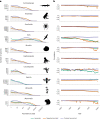Unveiling global species abundance distributions
- PMID: 37667000
- PMCID: PMC10555817
- DOI: 10.1038/s41559-023-02173-y
Unveiling global species abundance distributions
Abstract
Whether most species are rare or have some intermediate abundance is a long-standing question in ecology. Here, we use more than one billion observations from the Global Biodiversity Information Facility to assess global species abundance distributions (gSADs) of 39 taxonomic classes of eukaryotic organisms from 1900 to 2019. We show that, as sampling effort increases through time, the shape of the gSAD is unveiled; that is, the shape of the sampled gSAD changes, revealing the underlying gSAD. The fraction of species unveiled for each class decreases with the total number of species in that class and increases with the number of individuals sampled, with some groups, such as birds, being fully unveiled. The best statistical fit for almost all classes was the Poisson log-normal distribution. This strong evidence for a universal pattern of gSADs across classes suggests that there may be general ecological or evolutionary mechanisms governing the commonness and rarity of life on Earth.
© 2023. The Author(s).
Conflict of interest statement
The authors declare no competing interests.
Figures




References
-
- Fisher RA, Corbet AS, Williams CB. The relation between the number of species and the number of individuals in a random sample of an animal population. J. Anim. Ecol. 1943;12:42–58.
-
- Gray J. Pollution-induced changes in populations. Philos. Trans. R. Soc. Lond. B. 1979;286:545–561. - PubMed
-
- Preston FW. The commonness and rarity of species. Ecology. 1948;29:254–283.
-
- Dewdney A. A dynamical model of abundances in natural communities. Coenoses. 1997;12:67–76.
-
- Green JL, Plotkin JB. A statistical theory for sampling species abundances. Ecol. Lett. 2007;10:1037–1045. - PubMed
Publication types
MeSH terms
LinkOut - more resources
Full Text Sources
Research Materials

